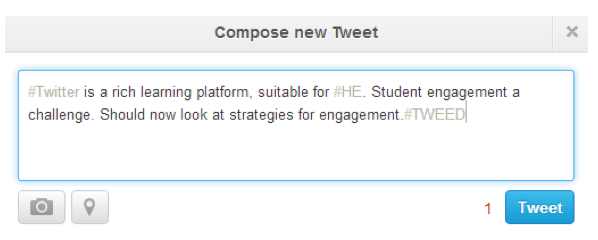The TWEED (Twitter in Education) Project which took place at the Physiotherapy Division in the University of Nottingham is now complete and a summary of the outcomes has been published. Roger Kerry, Associate Professor and lead for the project, found Twitter to have a rich and dynamic educational value however targeted higher education students did not meaningfully engage. It is becoming more important than ever for students to develop professional digital literacy skills and obstacles to engagement emerging from this study offer an opportunity for future research into strategies to facilitate novice entry into a rich learning environment.
IN BRIEF: The TWEED Project ran between 28th August 2012 and 16th December 2013. TWEED stands for ‘Twitter in Education’ and the project used a mixed methods approach to explore the educational value and utility of using the social micro-blogging site, Twitter, in higher education (HE). The project found Twitter to be a rich educational platform, but HE student engagement with it is a significant challenge.
TWITTER SUMMARY
FULL SUMMARY
BACKGROUND: Previous reports suggests that Twitter has an educational role, but this literature has focussed primarily on the ‘administrative’ dimension (communication about teaching logistics), and most research has been in secondary education. Existing educational research in the Division of Physiotherapy and Rehabilitation Sciences, University of Nottingham, looking at the impact of social learning in the classroom has indicated that students highly value peer-level social interaction as a source of knowledge construction. Twitter is a worldwide social interaction media. We therefore wondered if Twitter could act as a useful platform for higher education students’ learning.
METHODS: The project was centred in a physiotherapy undergraduate degree programme at the University of Nottingham. The target group consisted of 43 (13 male; 30 female) Year 1 physiotherapy students. A mixed methods approach consisted of focus groups and surveys to better understands students’ use, attitudes and beliefs about social media in general, and as an educational tool. A semi-structured 13 week themed Twitter- stream was introduced as part of a Year 1 undergraduate module (Evidence Based Practice 2). The stream was defined by a Twitter hashtag “#EBP2’. This allowed the stream to be searched, tracked, and recorded. Content analysis of the stream through coded themes was undertaken to establish the nature of communication within the hashtag. A hashtag user questionnaire was introduced, and a final undergraduate focus group conducted to identify factors influencing participation and post-stream attitudes and beliefs.
RESULTS: Prior to the hashtagged stream, the two most commonly used social media platforms for undergraduate physiotherapy students were Facebook and Twitter. Although these sites were used regularly for personal interest by high to moderate proportions of the group (Facebook 99%; Twitter 46%), the sites were used by less than 65% (Facebook) and 27% (Twitter) of students for educational purposes. During the 13 week hashtaged stream, 1076 relevant Tweets were recorded from 187 different Tweeters. Of these, only 1 was a targeted undergraduate student. 186 were external contributors consisting of predominately physiotherapy professionals (qualified and experienced physiotherapists), and a minority of external undergraduate students from other institutes’ physiotherapy courses. A seven week mid-theme data capture period of 503 tweets was used for content analysis. Eleven emergent themes (nature of tweets) were identified. Excluding re-tweets, the majority of tweets represented high educational value, e.g. 28% related to critical opinion; 26% related to information links. High levels of discussion and user-interaction were identified. All tweets represented some form of educational nature. A post-stream user survey found the platform was highly valued for educational purposes. Lack of engagement from the targeted population was a significant finding and post-stream focus groups identified four themes representing obstacles to engagement: discourse level (too high); novice insecurity (lack of experience); no ownership (professionals owned discourse); relevance to module (not obligatory). Student user profiles were identified as Participating Watcher; Participating Commentator; Non-participating Uninterested; and Non-Participating Future Participant.
DISCUSSION: Twitter was found to be a rich, dynamic educational environment, but was owned by a professional group rather than a HE student group. Targeted student engagement was a significant challenge. There is a recognisable set of factors which is likely to increase student engagement and participation on Twitter. The data can be used to further develop and contribute to theory regarding online Communities of Practice. We have formally coined the term electronic Communities of Practice in Information Exchange (e- CoPIE) to explore strategies for HE learning which should help with bridging HE novices and relevant professionals within micro-blogging spaces and which might support learning with social media across subjects. Insights stem from the analysis and understanding of micro- blogging interactions, as well as students’ opinions as expressed in two focus groups. These findings could be of significant value for the HE community, especially considering the current focus of HE policy on digital and flexible learning, and graduate employability. Participation in an e-CoPIE could, for example, be a lever for enhanced employability prospects of graduates across a range of fields.
CONCLUSION: This study found the social network micro-blogging site Twitter to have a rich and dynamic educational value. Targeted HE students did not, however, meaningfully engage. Rather, the discourse was ‘taken over’ by experienced physiotherapy professionals. This in itself is an advantageous characteristic of open-access media, but in this case represented an obstacle for student engagement. The educational environment reflected and worldwide, multi-user community of practice. We have developed the unique notion of an electronic Community of Practice in Information Exchange. Obstacles to engagement emerging from this study offer an opportunity for future research into strategies to facilitate novice entry into a rich learning environment.
